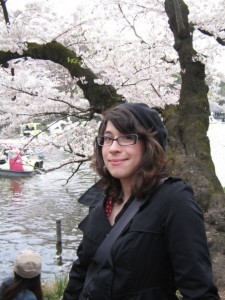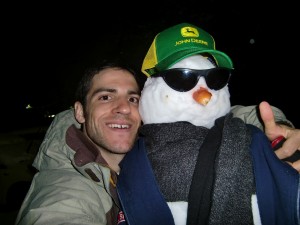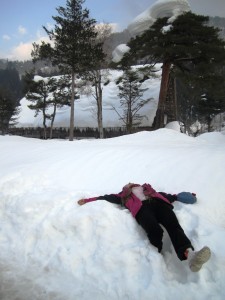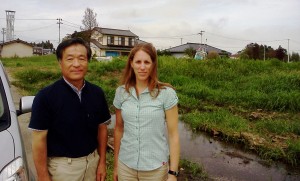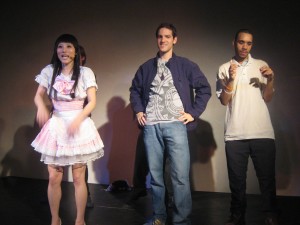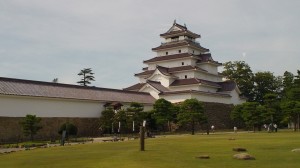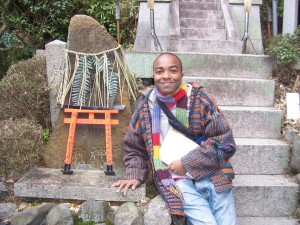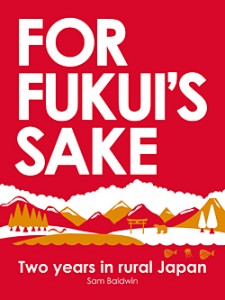
"The author's final thoughts about his stay in Japan struck a chord with me. Though many people seek adventures in foreign lands, if they stay in one place long enough, they often find it's the people they befriended that end up meaning the most to them upon their departure." (Baka Books)
By Tim Martin (Fukui-ken, 2006-08) for JQ magazine. Tim works as a research assistant in a neuroscience lab, and is an avid swing and blues dancer in New York City. He runs a humanist/atheist blog, The Floating Lantern, and is looking for ways to make a difference in people’s lives.
Fukui is a rural, out-of-the-way prefecture, relatively unfamiliar even to the Japanese. It boasts the largest number of nuclear reactors in the country, but only a single Starbucks. It’s home to a Buddha statue larger than the one in Nara, which, curiously, very few tourists come to visit. Fukui also has an amusing reputation for getting terrible reviews from authors who’ve passed through—in his book Hitching Rides with Buddha (aka Hokkaido Highway Blues), fellow JET alumni author Will Ferguson (Nagasaki-ken, 1991-94) describes it, only half-jokingly, as “a hole.”
So it’s an interesting place.
It’s also where Sam Baldwin (Fukui-ken, 2004-06) ended up when he applied to teach English in Japan as a member of the JET Program. In For Fukui’s Sake, Baldwin recounts tales from his two-year stay in this quirky rural backwater, weaving together the varied strands of his experience to form a continuous narrative of adventure and personal growth.
While working a monotonous job as a “research lab technician” in the UK, Baldwin decided he needed to broaden his horizons. Looking to discover what else life could offer, he set his sights on Japan, which, according to a friend who had visited, was a place where Baldwin could indulge in his love of snow and mountains. This may be a casual way to make the decision to start a new job in a strange country, but the required spontaneity and openness to new experiences may be what ultimately allowed the author to glean so much from his time in Japan.
JQ Magazine: Life after JET – The Employment Conundrum
By Geneva Marie (Niigata-ken, 2008-09) for JQ magazine. Geneva works as an account manager in the vast Great Plains a.k.a. Omaha, Nebraska and is a (sometimes) contributor to JETwit. Contact Geneva at geneva [dot] sarni [at] gmail [dot] com and visit her on LinkedIn.
It’s 8 a.m. on a chilly morning in December and I’m sitting at my desk in a thoroughly nondescript building located on the edge of Omaha, Nebraska’s suburban sprawl. I’m checking my interoffice e-mail and yielding phone calls—typical cube-rat chores. I’ve got my coffee and my Spotify, and oh right, I’m writing this article during my downtime. When I think about my daily routine, I realize that it’s a far cry from what I was doing two and a half years ago when I was teaching English to elementary and middle school students in rural northern Japan on the JET Program.
Like everyone who returns from living abroad, I found myself suffering from the typical culture shock and malaise. However, the readjustment to regular life, a regular job, and a regular me—the life I had before my time on JET—has been a continuous uphill battle. It’s been a very trying two years, a strange journey that has somehow left me feeling isolated and worlds away from my former home in Japan, taking me to a place I never thought I’d end up in. Not to mention feeling like I will never get the chance to work in a Japan-related field anytime soon.
My story begins in the frozen metropolis of Minneapolis, where as a 24-year-old, non-traditional student I reenrolled in college at the University of Minnesota as an Asian studies major (emphasis in Japanese, of course). Admittedly, I wasn’t the best Japanese student. I was older than most of my peers and thus (I felt), at a disadvantage. I struggled through two years of language learning before deciding at 26 to embark on my first trip out of the country—a study abroad in Tokyo. It was a life-altering experience for me and probably the most expensive thing I have ever done. It was so life-changing that I often look back at life in my twenties as “before and after Japan.”
JQ Magazine: Concert Review – L’Arc~en~Ciel Take Madison Square Garden by Storm

L'Arc~en~Ciel frontman hyde at the band's historic Madison Square Garden show, March 25, 2012. (Courtesy of BAM! Marketing, Publicity & Promotions)
By Sam Frank, an ALT who taught English in Hiraizumi-Cho, Iwate-ken, from 2002-04 and worked in Shirahama-cho, Wakayama-ken as a JET from 2004-06, for JQ magazine. He currently manages the New York division of UnRated magazine and works as a project manager/Web producer at Arrow Root Media.
A few years ago I went to the MTV Video Music Awards in Japan, and noticed something interesting. Whenever categories came up where American artists went against Japanese artists, nine out of ten times, the American would win, and not even be in attendance to accept the award. It seemed so unfair to compare American artists to their Japanese counterparts when you think about how many American bands have sold out stadiums in Tokyo while most Japanese bands that tour America have a hard time filling up mid-size venues such as Roseland Ballroom and Irving Plaza in Manhattan. That comparison doesn’t seem quite so unfair after watching L’Arc~en~Ciel (French for rainbow), a band formed in Osaka, cement its name in rock history as the first Japanese band to perform at New York City’s famed Madison Square Garden on March 25.
In celebration of the band’s 20th anniversary making music together, hyde (lead vocals), tetsuya (bass), ken (guitar), and yukihiro (drums) have taken their dynamic visual spectacle around the globe to thank fans in true rock star fashion. The show got underway with an epic opening video displaying the band members’ names carved in platinum scrolling across the screen before showing a beautiful butterfly landing in Hyde’s glove-clad palm.
As the excited crowd eagerly waved their florescent glow sticks in anticipation, L’Arc~en~Ciel stormed the stage backed by the enchanting piano intro to “Ibara no Namida” (いばらの涙). The instant the spotlight dropped on hyde, the Garden erupted into a surge of screams and cheers for the international superstar. Juxtaposing band members with various computer generated ethereal images, songs like “Good Luck My Way,” the theme song to 2011′s FullMetal Alchemist The Movie: The Sacred Star of Milos, “My Heart Draws a Dream,” and “Honey” all came to life in a fresh and exciting way. The visual narratives added another level of interactivity to each song, which is why concertgoers who might not be familiar with songs like 1999′s “Driver’s High” will remember it as the song that opened with a revving engine sound, pyrotechnics, and images of white smoke spreading across the three gigantic LED screens.
For the complete story, click here.
JQ Magazine: Book Review – ‘Tomo: Friendship through Fiction: An Anthology of Japan Teen Stories’
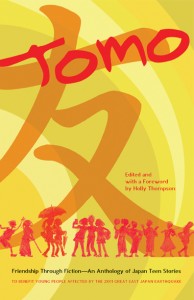
“Reading ‘Tomo’ is a reminder that even in the most desperate straits, friendship and personal relationships have the power to nourish and sustain us.” (Stone Bridge Press)
By Sharona Moskowitz (Fukuoka-ken, 2000-01) for JQ magazine. Sharona is interested in fresh, new voices in fiction and creative nonfiction.
If you could know your future cause of death, would you choose to know? This is the question posed by “Yamada-san’s Toaster,” one of the short stories in the new fiction anthology Tomo: Friendship through Fiction: An Anthology of Japan Teen Stories. As the title suggests, the collection is geared toward adolescents and dedicated to the youth of Tohoku, though it undoubtedly has— in the parlance of publishing— tremendous crossover appeal. There is plenty for adults to enjoy here, too. Edited and with a foreword by Holly Thompson, this collection features 36 stories—including 10 in translation—contributed by several JET alums from around the world, all of whom share a connection to Japan. Proceeds from its sale will go directly to the continued relief efforts.
In Kelly Luce (Kawasaki/Tokushima, 2002-04)’s story, Yamada-san’s toaster burns into each slice of bread a Chinese character supposedly predicting one’s cause of death. The tale’s young narrator observes the effects of the toaster on the townspeople as news spreads and they become stirred into a ridiculous pandemonium. There’s a great element of humor to the story though it also reveals a universal human folly: the vulnerability towards superstition. People try desperately to find order and make sense of a chaotic and random world, even if it means looking for burnt kanji of the toast on a breakfast plate.
The stories are grouped thematically, represented by “Shocks and Tremors,” Friends and Enemies,” “Ghosts and Spirits,” Powers and Feats,” Talents and Curses,” Insiders and Outsiders” and “Families and Connections.” (The final story, the poignant “Peace on Earth,” is penned by Suzanne Kamata (Tokushima-ken, 1988-90), whose own book of short stories, The Beautiful One Has Come, was released last year.
JQ Magazine: On Japanese Winters and Well Endowed Snowmen
By Preston Hatfield (Yamanashi-ken, 2009-10) for JQ magazine. Preston moved from San Francisco to New York City in January 2012 and is now accepting submissions from people who want to be his friend. Abduct him from his house in the middle of the night, or find him on Facebook and ask about his JET blog in which he details his exploits and misadventures in that crazy Land of the Rising Sun we all love.
On JET it may be true that everyone’s situation is different, but I’d bet my left dango that each of us, for whatever extenuating circumstance, suffered a few restless nights without heat in our rooms. My bone-chilling tale of refrigery and woe took place when 2010 was newly born, in the sweeping valleys of Yamanashi Prefecture. I lived in Kofu’s International Exchange Center, a westernized building converted from an old motel with all the comforts of home: shower, central heating, high speed Internet, furnished everything—which is to say I’d gotten used to a very comfortable lifestyle. I was overdue for a slice of humble sashimi.
I should mention that Kofu is not a cold place. It usually gets one storm where the snow sticks, and even that only lasts a few days. But that means nothing to a California boy. The moment my room dropped below its usual 72 degrees of moderation I knew I was in for it and got my building supervisor on the phone. He showed up a few minutes later, a shrunken old man who’d apparently won the battle against time, for indeed time had already done its worst and still the man was up and (very gradually) at ’em.
“A couple of days,” he told me after examining the fuses. “You’ll have to hang in there until then.” I looked out my window where the sky was semi-busy dropping the one good bit of snowfall we’d have that year. By now I imagined the temperature inside had dipped into the upper 60s and the first stages of hypothermia couldn’t be far off. Neither could the epic hissy fit I was about to throw.
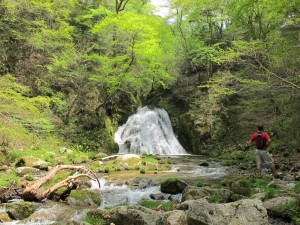
At scenic Setogaro Gorge in Iwaki, fifth year JET Peter Gillam says people are not seeing Fukushima for everything it is. “What people need to know most about Fukushima is that it is a prefecture first, a city second, and a nuclear reactor a distant third,” he says. “Not the other way around.”
Who’s telling the truth about radiation in Japan, and why it might not matter anyway.
By James A. Foley (Fukushima-ken, 2007-10) for JQ magazine. James was one of eight American JET alums selected for the Tohoku Invitational Program sponsored by the Ministry of Foreign Affairs and the Japan Tourism Agency.
Nastassja Vidro knew something was awfully wrong when the March air turned yellow.
It happened while she was outside on the playground with the eight students she taught English to at Shiramizu Elementary in Iwaki City, Japan, after the earth began to move.
Vidro, a 2007-2011 JET participant, was by then an old pro at earthquakes. She had lived in seismically active Japan nearly four years, and in California for more than two decades before that. But this quake was different. The earth rocked so violently that huge clouds of pollen erupted from the trees and hung in the air, casting the scene in an eerie hue.
The school principal ran outside, telling everyone to get in the center of the schoolyard and huddle together. Crouched on the ground with her students, Vidro kept waiting for the tremor to subside, but it went on. For six minutes.
She heard a fantastic noise—“like a monster roaring, not screeching, but deep, [and] I could hear the wood creak and bend and the earth move”—and ceramic shingles rattling off neighboring houses and shattering on the pavement.
She says she felt the ground quiver beneath her. She fixated on it, amazed.
“My hands were on the ground and the movement was pushing them off,” she says. “I’m not a very religious person, but I was praying so hard. I hoped the earth didn’t crack.”
She looked toward a fellow teacher, a Japan native, whose eyes were wide.
“I could see in her face that this was bad, that it was not an average earthquake,” she says.
JQ Magazine Seeks Writers for Spring 2012!
As we march into spring, JETAA New York’s JQ magazine continues to provide content with an ever-expanding array of articles, interviews and features (see our recent stories here). We’re now looking for new writers, including recent returnees and JET vets, from all JETAA chapters worldwide for posting stories via our host at the global JET alumni resource site JETwit.com. (Scribes are also encouraged to join the JET Alumni Writers group on LinkedIn.)
Below are story ideas grouped by JET participants and alumni (JET World) and those more on Japanese culture (Japan World). If you’re a JET or JETWit contributor from anywhere in the world, we welcome your interest or additional story ideas! Contact JQ’s editor Justin Tedaldi (magazine [at] jetaany [dot] org) to sign up for stories, and click here to see the story ideas online.
Click “Read More” below for our spring 2012 ideas pitch package.
By Wendy Ikemoto (Ehime-ken, 2006-2011). Wendy taught at six crazy but lovable high schools and served as a Prefectural Advisor on JET. Now based in the equally crazy New York City, she is looking for her next challenging career opportunity. Wendy is a fan of reading, writing, and cooking as a form of socialization. Visit her LinkedIn profile here.
I learned the hard way that bicycles and snow don’t mix.
It wasn’t that I didn’t have my suspicions about this, but I: a) Needed to get to the train station, and b) was inexperienced with the fluffy stuff (it was only the second time in years that snow in my country town hadn’t immediately melted away, and as a Hawaii girl, the snow seemed more novelty than threat).
So on a January morning in Ehime, I left my apartment to catch a train into town. I followed the same route to the station that I used hundreds of times. I rode past a small temple on the hill. I enjoyed watching the animals in the river along the road. I took the turn by the bridge and in slow motion, my tire slipped out from under me and I crashed. SMACK–I fell on the back of my head.
I couldn’t move for a moment.
Before I could regain composure, I started to get dragged off. A kind Japanese couple had seen the whole thing and sensibly moved me out of the road. I was very grateful, but hugely mortified. After about a minute, I thanked them profusely, assuring them that I was OK, and managed to get back on my bicycle. Slowly and wobbly, I made it to the station.
I met my friend, we bought our train tickets, and through the gate we went to wait for our train. This was my first moment to relax since the accident. Although I felt fine, I decided to inspect the back on my head. Lightly, my fingers caressed where I crashed until they came upon a bump. Not the hard kind that happens when you knock your head against a shelf, but the soft kind that happens when you have a blister. Crap. Well, maybe I can go to the doctor tomorrow, I thought.
When I brought my hand down into my lap, however, I noticed that it looked funny…there was blood all over it.
By Amy Cameron (Fukushima-ken, 1998-2000) for JQ magazine. Amy was one of eight American JET alums selected for the Tohoku Invitational Program sponsored by the Ministry of Foreign Affairs and the Japan Tourism Agency.
I will always remember the day back in 1998 that I received my JET ALT assignment. I immediately rushed to a map to see where I would be living. I hadn’t studied Japanese before, so it was hard to pronounce the words: Nihonmatsu-shi, Fukushima-ken. My tongue tripped on the syllables and I laughed. I found the spot on a map, about halfway between Tokyo and Aomori, 35 miles or so from the coast, between some mountains. I tried to imagine what it would be like to live there. As my departure approached, friends and family asked where in Japan I was heading, but no one had ever heard of Fukushima.
Fast forward to the days following March 11, 2011, and suddenly the whole world had heard of Fukushima. Amidst the media overload of earthquake, tsunami, and radiation disaster images, friends and family called and e-mailed me, “Was that where you used to live?” I scrambled to contact friends and coworkers in the region. My former supervisor cried when he heard that I was thinking of him. People in Nihonmatsu were okay, he assured me. The earthquake had not done as much damage as in some other areas, and Nihonmatsu was far enough from the coast that it had not been hit by the tsunami. Radiation, on the other hand, was a growing concern.
At this time, my heart ached to return to Fukushima to visit the people and land I loved so dearly. I had spent two amazing years there as an ALT, and it had been hard to leave. Even as news of the disasters began to fade from the headlines, I felt distracted from my life in Boston, part of me emotionally back in Fukushima. When I heard about the Tohoku Invitational Program for JET alums a few months later, I was so excited that I had a hard time sleeping. This was it: a real opportunity to return to my Japanese hometown, much sooner than I had thought would be possible.
By Preston Hatfield (Yamanashi-ken, 2009-10) for JQ magazine. Preston moved from San Francisco to New York City in January 2012 and is now accepting submissions from people who want to be his friend. Abduct him from his house in the middle of the night, or find him on Facebook and ask about his JET blog in which he details his exploits and misadventures in that crazy Land of the Rising Sun we all love.
The Bennett Media Studio in New York’s West Village was filled to capacity on Feb. 11 for Saturday’s Lunar New Year Celebration and Fashion Show. This event, hosted by the ASIANinNY networking organization, treated guests to a night of Asian-oriented exhibitions, highlighted by two fashion shows and an energetic performance by cosplay singer and Japanese idol Reni Mimura.
The boys took the stage first, modeling clothes by designer Ninh Nguyen and eliciting a number of lascivious hoots and catcalls from an appreciative crowd, and the girls, wearing Meiling Chen’s new line, came out to a barrage of camera flashes. Fitting with the Year of the Dragon, the models’ hair, stylized by a team from Haruo Noro Salon, exhibited a quiet ferocity and mystique.
“For [the girls] the look is a simple and romantic boho style, center part, with a low ponytail and a braid. For [the boys] the look is a ’60s mod, edgy/punk, with a modern and clean feel,” lead stylist Noro said of his artistic intent. Having worked and studied in salons in Japan and London before coming to New Jersey and establishing his own business, Noro explained that for this event he drew mostly from his Japanese training, though having additional training and work with other cultures and participating in various fashion shows has enhanced his creative vision.
“I love that ASIANinNY is able to feature and promote various Asian designers, and my team and I are very happy to be part of it,” he said.
By Kris Gravender (Fukushima-ken, 2002-06) for JQ magazine. Kris was one of eight American JET alums selected for the Tohoku Invitational Program sponsored by the Ministry of Foreign Affairs and the Japan Tourism Agency. This article was originally printed in the Oct. 21, 2011 issue of Chicago’s bilingual newspaper Chicago Shimpo.
What could I do? What could I really do? I was fighting the urge to return to Aizu simply because I knew the possibility for contracting some kind of cancer, but I felt I just had to do something. When the earthquake hit we knew it was bad, but the tsunami made everything worse. Then, to top it all off, Fukushima was becoming a “nuclear wasteland,” according to the news reports we were getting, and there was nothing we could do for the place we love.
My wife, being from Aizu, was distraught for weeks. She called her family, friends she hadn’t talked to in years, and even the local International Association, to get as much news as possible. Her aunt and uncle live in Sendai, and there was no communication from them, not to mention that her brother is a police officer and was being sent into the radiation zone to assist with evacuations. Eventually we were told everyone was safe and healthy, and yet this didn’t do much to make us feel better. We donated money, clothes, and food to the Red Cross, but it just didn’t seem to be enough to make us feel like we were helping.
Then I heard from a friend about a program the Ministry of Foreign Affairs was sponsoring for JET alums to return to their hometowns and tour, as long as they communicated with the outside world about what they saw, felt, and experienced. It was almost as if God was trying to tell me, “Here’s your chance.” My wife and I talked about it for days: If I go, what kinds of problems would I face; what would I do while I was there; could I go into the zone for just a couple of hours to see for myself what was happening; and a whole list of questions and ideas. No matter what the answers became, I knew I had to go.
JQ Magazine: Film Review – ‘Norwegian Wood’
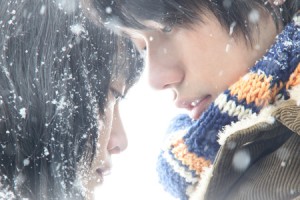
“The wintertime beauty of the Tonomine highlands in Hyogo prefecture is a sadly haunting visual expression of Naoko’s isolation and loss of life. One only wishes the characters were as compelling as the landscape in which they find themselves.”
By Lyle Sylvander (Yokohama-shi, 2001-02) for JQ magazine. Lyle is entering a master’s program at the School of International and Public Affairs at Columbia University (MIA 2013) and has been writing for the JET Alumni Association since 2004. He is also the goalkeeper for FC Japan, a New York City-based soccer team.
Haruki Murakami’s novel Norwegian Wood 「ノルウェイの森」 was published in Japan in 1987 and propelled the author to superstar status, especially among the nation’s youth. The novel was also an international success and the first English translation (there were eventually two) introduced Murakami to the U.S.
Unlike his other well-known works, such as Hard Boiled Wonderland and the End of the World and The Wind-Up Bird Chronicle, Norwegian Wood eschews surreal and Kafkaesque sensibilities in favor of a more nostalgically sentimental narrative. It tells the story of love and loss from the vantage point of its 37-year-old protagonist, Toru Watanabe, looking back on his youth as a student during the 1960s.
As in Europe and the U.S., Japan at that time was a society in flux and the establishment was being challenged by idealistic student movements. Against this backdrop, Toru falls in love with the emotionally troubled and fragile Naoko, who sinks into a deep depression after the suicide of their mutual friend Kizuki. She leaves the university for a mountainous sanitarium and during her absence, Toru has a love affair with Midori. Eventually, Naoko succumbs to the darker nature of her illness and commits suicide, sending Toru into an emotional period of bereavement, after which he can commit emotionally to Midori and continue on with his life.
JQ Magazine: JQ&A with JUSTE Program Participant Kazumoto Takechi
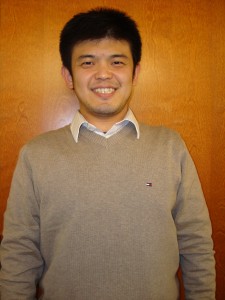
"I would like the duration of stay in this project extended as long as possible. Hopefully, this project will revolutionize Japanese English education just as the JET Program has changed the landscape of English language education in Japan."
By Sierra Soleil (Fukushima-ken, 2000-02) for JQ magazine. Sierra works at an ESL school in Manhattan. He enjoys teaching, writing, and riding his bike.
It’s been called the “Reverse JET Program,” which is a lot catchier than the Japan-U.S. Training and Exchange Program for English Language Teachers (JUSTE Program). A few of the East Coast JUSTE teachers made a special public appearance at the JETAANY Welcome Back Reception in November, and since then there has been some talk about exactly what this program is, and what these teachers are up to.
Recently, Kazumoto “Kaz” Takechi, a JUSTE participant at Rutgers University in New Jersey, took some time out of his busy schedule to answer a few questions about his experience as a Reverse JET. Spoiler alert: the program is very new, and its future is not assured, especially with the budget restrictions caused by the problems in Fukushima. However, if Kaz’s attitude is at all typical of the other participants, JUSTE could be every bit as much of a game-changer as JET was.
Kaz got his MA in English education from Naruto University of Teacher Education in 2002, and works at Ishii Junior High School in Tokushima, Shikoku. He was nominated by the program as one of 96 Japanese teachers of English to spend six months in the U.S. through January of this year, and is the only JUSTE teacher from Tokushima. Before he got to my questions, Kaz started with a shout-out to his former ALTs:
“All of my ALTs have been great partners in the classroom. I am a very lucky teacher because I have met very wonderful ALTs during my nine years as an English teacher. I am really glad to participate in this article for ALTs.”
Where did the idea come from to send teachers to the U.S. in order to improve English education in Japan?
According to the Foreign Ministry Advance Institute Workshop held at Tokyo in May 2010, both Japan and the United States agree that the two countries need to foster mutual understanding at the citizen level in order to sustain and strengthen the Japan-U.S. alliance. Based on this agreement, a summit conference between Japan and the U.S. was held in Yokohama on November 13, 2010. Details on how to strength our relationships were finalized during this conference. The JUSTE project is a direct outcome of this conference. The Ministry of Education further defined that the JUSTE project had two objectives. One is to foster and develop the English communicative skills of Japanese English teachers. The other is to develop Japanese English teacher pedagogical skills through TESOL classes offered at U.S. institutions.
Has this idea been around for a long time, or was it a recent initiative?
The Ambassador Plenipotentiary has wished that this project take motion for some time. He has consistently envisioned the necessity to give Japanese English teachers the opportunity to seek professional development, in English speaking countries such as the U.S., after they become certified English teachers in Japan. He has consistently suggested this to the government, and thanks to his wonderful efforts this project has finally materialized.
How would you assess the progress so far?
At this juncture, I am focusing on developing the skill sets that will contribute to the professional development of Japanese English teachers and ALTs when I return to Japan. I will be presenting to the English language teacher community as well as conducting demonstration lessons to assist in their professional development. Moreover, I will also write some articles about my experience in this project. Hopefully, I will inspire other English teachers and muster support for this project among supervisors and English language teachers. This is a challenge I am embarking on, but I have conviction that my actions will positively influence other English teachers and the future of Japanese English education.
JQ Magazine Needs New Writers for Winter 2012!
 As we welcome a new year, JETAA New York’s JQ magazine continues to provide content with an ever-expanding array of articles, interviews and features (see our recent stories here). We’re now looking for new writers (including new returnees and JET vets) from all JETAA chapters worldwide to write and share more material that we can post online to the widest JET readership on the web through our hosts at the global JET alumni resource site JETwit.com.
As we welcome a new year, JETAA New York’s JQ magazine continues to provide content with an ever-expanding array of articles, interviews and features (see our recent stories here). We’re now looking for new writers (including new returnees and JET vets) from all JETAA chapters worldwide to write and share more material that we can post online to the widest JET readership on the web through our hosts at the global JET alumni resource site JETwit.com.
Below are story ideas grouped by JET participants and alumni (JET World) and those more on Japanese culture (Japan World). If you’re a JET or JETWit contributor from anywhere in the world, we welcome your interest or additional story ideas! Click “Read More” below to see our story ideas, and contact JQ’s editor Justin Tedaldi (magazine [at] jetaany [dot] org) to sign up.
JQ Magazine: In Kyoto, a New Year’s Day Disaster
By Rashaad Jorden (Yamagata-ken, 2008-2010) for JQ magazine. Rashaad worked at four elementary schools and three junior high schools on JET, and taught a weekly conversion class in Haguro (his village) to adults. He completed the Tokyo Marathon in 2010, and was also a member of a taiko group in Haguro.
New Year’s Day. A day some welcome in a crazed stupor while others might celebrate it in serenity. Or maybe confusion.
I would be spending my New Year’s Day on vacation in the Kansai region. Upon getting off the bus in Osaka, I had no idea what locales I’d explore. But my plans were nothing to be stressed about as I’d simply follow the recommendations of my Lonely Planet.
And others. Shortly after checking into my hostel in Osaka, I met an American college student on a homestay in Tokyo. She had come to town for the same reason I had. So quite naturally, we started to talk about places worth visiting in the Kansai region. Fortunately for me, she was familiar with several tourist spots in the area.
I definitely knew about Kyoto’s infinite number of shrines, but I wasn’t sure which ones to visit. However, my compatriot recommended Kiyomizu-dera, Kinkaku-ji, and Fushimi Inari-taisha.
So I was off to Kyoto the next day. I crossed the first two locales off my list, but I didn’t have time to fit in Fushimi Inari-taisha. No worries—I had two more days in the region. My biggest concern was finding something to do other than going to bed at 10 p.m. on New Year’s Eve. Fortunately, four other Yamagata Prefecture ALTs who were taking a road trip to Hiroshima stopped in Osaka that night, so I had some friendly faces to ring in the new year with.

